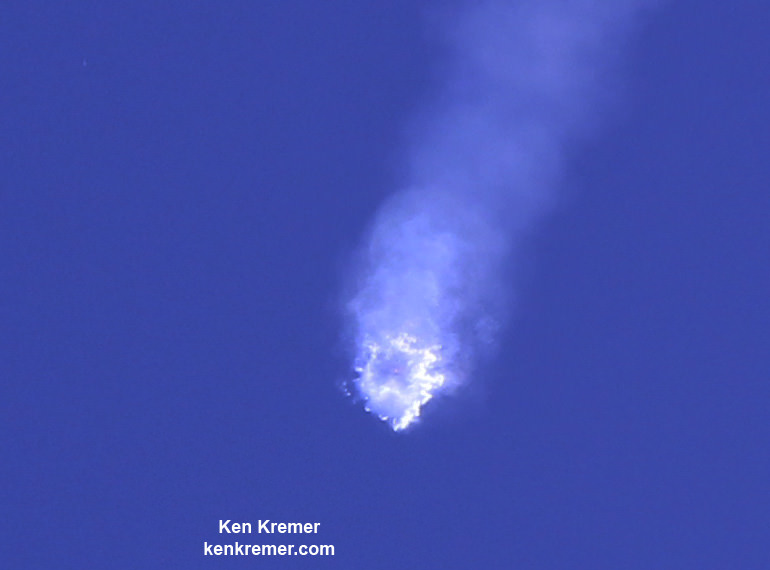KENNEDY SPACE CENTER, FL – A SpaceX Falcon 9 rocket and Dragon cargo ship loaded with critical supplies for the International Space Station (ISS) were destroyed by a catastrophic explosion starting approximately 148 seconds after a successful blastoff today, June 28, from Space Launch Complex 40 at Cape Canaveral Air Force Station in Florida at 10:21 a.m. EDT.
“Eastern Range confirms the Falcon 9 and Dragon vehicle broke up,” according to the USAF Eastern Range, 45th Space Wing as the vehicle was in flight and the first stage was firing.
The failure was immediately obvious to all of us watching the launch live on site from the Kennedy Space Center press site when the rocket disappeared into a expanding white cloud that was totally abnormal. See my launch and explosion photos herein.
“At this point, it’s not clear to the launch team exactly what happened,” NASA Launch Commentator George Diller reported on the live NASA TV broadcast.
It was the third launch failure of a cargo delivery run to the space station in the past half year -including both American and Russian rockets.
The Falcon 9 stopped ascending and broke apart and an abnormal vapor streak formed ahead of the rockets planned ascent path to orbit.
Within moments falling debris was visible in eyewitness photos from multiple angles.

“Falcon 9 experienced a problem shortly before first stage shutdown. Will provide more info as soon as we review the data,” tweeted SpaceX CEO Elon Musk soon after the explosion.
The pressurized section of the Dragon was packed with over 4,000 pounds of research experiments, spare parts, gear, high pressure supply gases, food, water and clothing for the astronaut and cosmonaut crews comprising Expeditions 44 and 45 on the ISS.
Details to follow

Watch for Ken’s continuing onsite coverage of the CRS-7 launch from the Kennedy Space Center and Cape Canaveral Air Force Station.
Stay tuned here for Ken’s continuing Earth and planetary science and human spaceflight news.
………….
Learn more about SpaceX, Boeing, Space Taxis, Europa, Rosetta, Mars rovers, Orion, SLS, Antares, NASA missions and more at Ken’s upcoming outreach events:
Jun 28: “SpaceX launch, Orion, Commercial crew, Curiosity explores Mars, Antares and more,” Kennedy Space Center Quality Inn, Titusville, FL, evenings


http://cosmoquest.org/forum/showthread.php?157516-SpaceX-6-28-15-ISS-launch-anomaly&p=2297432#post2297432
silence on the comments ….
I watched the live vid
the pre-explosion looked like the zoomed in camera shaked a bit until it had a steady focus, all the while plumes of white gas trailed the exhaust like irregular billowing clouds, not part of the rocket exhaust.
a second or 2 after the rocket/(camera) steadied itself the rocket disintegrated into multiple pieces.
I agree, The white gas appeared to come from the second stage. It looked like there was something wrong in the second stage, or the second stage ignited too early. Or both??
No joy… no fresh fruit, coffee or veggies… dwindling launch backup cap. is spooky. That’s 3 major failures and counting…
3 major failures yes, but not of SpaceX. So, now it seems that the most successful launcher system around is the Ariadne… but much more expensive. However, as Elon said, this is a risky business, were 100% all the time is not what rocketry is about today.
Yes, the Antares w/the Cygnus exploded seconds after lift off. Then a Soyuz/Progress was lost and now the Dragon…
Just prior to the Antares booster failure, Elan Musk said, “One of our competitors, Orbital Sciences, has a contract to resupply the International Space Station [ISS], and their rocket honestly sounds like the punchline to a joke.” He was referring to the “built in the 60’s” Russian rocket engines Antares used. Now it’s Elan who must be humble and open to criticism?
I guess the question is, how will the industry deal with this shortfall? Or, how soon will SpaceX launch again to the ISS?
The privatization of space flight remains in its infancy…and showing great signs of struggle. Hard to imagine manned flights from the private sector anytime this decade.
maybe, but remember NASAs failures? It has nothing to do with privatization!
I would say the opposite.
I remember the Challenger disaster, and I remember the saying,
“good enough for Government work”.
In the private sector your job is on the line, not so for govt. work.
In which sector is the highest incentive to improve design andquality control?
Latest tweet says
“Cause still unknown after several thousand engineering-hours of review. Now parsing data with a hex editor to recover final milliseconds.”
an overpressure event that happens in milliseconds? Sounds like an explosion. How does that happen in an unlit stage and very suddenly when you everything monitored?
If the Dragon space ship had been the newer model, wouldn’t it have the capability of ‘saving’ itself and its ‘crew’ of equipment by escaping this ‘anomaly’ by jettisoning off and parachuting back to the earth? I realize that this version isn’t ready for current applications yet, but still wouldn’t this have been possible?
Secondly, the question or argument of privatized space companies.
Lockheed, Boeing, etc. etc. are all private companies providing their rockets and hardware to the military and NASA. How is this much different from Space X, except maybe they have been around a lot longer and are more integrated in the ‘system’. They all serve outside-of- the-government organizations to launch their wares.
Yes. The Space Shuttle was the last design that didn’t have an escape on launch system for people in place. We learned our lesson the hard way.